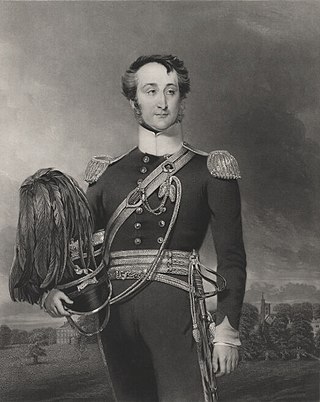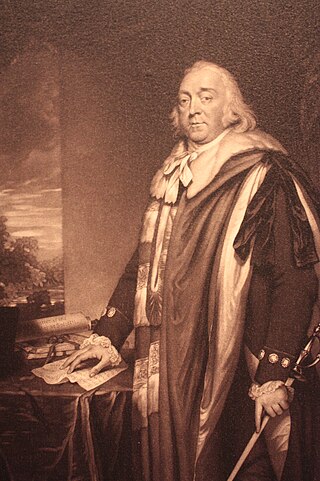Related Research Articles

Baron FitzWalter is an ancient title in the Peerage of England. It was created on 24 June 1295 for Robert FitzWalter. The title was created by writ, which means that it can descend through both male and female lines.
The Bishopp Baronetcy, of Parham in the County of Sussex, was a baronetcy in the Baronetage of England. From around 1780 the name was sometimes also spelled Bisshopp. It was created 24 July 1620 for Sir Thomas Bishopp who had previously represented Gatton in Parliament. He was by then almost 70 years old and who had earlier been created a knight by King James I on 7 May 1603 at Theobalds, shortly after James's accession to the throne. Thomas Bishopp was the son of Thomas Bishopp and Elizabeth Belknap, heir and daughter of Sir Edward Belknap, who was active in the service of the English crown, both on the battlefield and as a court official.

There have been four baronetcies created for members of the Acland family, which originated in the 12th century at the estate of Acland in the parish of Landkey, North Devon, two in the Baronetage of England and two in the Baronetage of the United Kingdom.

Goodnestone is a village and civil parish in the Dover district of Kent, England. The village is situated approximately 7 miles (11 km) east-southeast from the city of Canterbury, and 5 miles (8 km) west-southwest from Sandwich. The civil parish also contains the villages of Chillenden and Knowlton, and the hamlets of Rowling and Tickenhurst.
The Bridges Baronetcy, of Goodnestone in the County of Kent, was created in the Baronetage of Great Britain on 19 April 1718 for Brook Bridges. His son the second Baronet, died in 1733 whilst in office as High Sheriff of Kent. His grandson, the third Baronet, represented Kent in the House of Commons. In 1842, the fifth Baronet, unsuccessfully claimed the ancient barony of FitzWalter as a descendant of Mary, sister of the seventeenth Baron FitzWalter. He later sat as a Member of Parliament for Kent East. In 1868 he was created Baron FitzWalter, of Woodham Walter in the County of Essex, in the Peerage of the United Kingdom. However, the peerage became extinct on his death, while he was succeeded in the baronetcy by his younger brother, the sixth Baronet. On his death the title passed to his first cousin, the seventh Baronet. He was the son of Reverend Brook Henry Bridges, third son of the third Baronet. When he died this line of the family also failed and the title was passed on to his first cousin, the eighth Baronet. He was the son of Reverend Brook Edward Bridges, fourth son of the third Baronet. He never married and on his death in 1899 the baronetcy became extinct.

Sir Edward Cust, 1st Baronet, KCH was a British soldier, politician and courtier.

Sir Brook William Bridges, 3rd Baronet was a British baronet and Whig politician.

The Hales Baronetcy, is a title in the Baronetage of England. There were three Hales baronetcies. The oldest was created in 1611 for Edward Hales. He was a member of a Kent family. The second was created in 1660 for Robert Hales, MP for Hythe 1659, also of a Kent family. The third was created in 1660 for John Hales of Coventry, co. Warwick.

Sir Thomas Hales, 3rd Baronet, of Beakesbourne in Kent, was an English courtier and Whig politician who sat in the House of Commons for 37 years between 1722 and 1762.
Sir Thomas Hales, 2nd Baronet, of Bekesbourne and Brymore in Kent, was an English politician who sat in the English and British House of Commons between 1701 and 1747.
Sir Henry Cheere, 1st Baronet was a renowned English sculptor and monumental mason. He was the older brother of John Cheere, also a notable sculptor.

Sir John Hoskyns, 2nd Baronet FRS was an English baronet.

Sir Harry Verney, 2nd Baronet PC, DL, JP was an English soldier and Liberal politician who sat in the House of Commons variously between 1832 and 1885.

Brook William Bridges, 1st Baron FitzWalter, known as Sir Brook Bridges, Bt, between 1829 and 1868, was a British peer and Conservative politician.

Charles Marsham, 1st Earl of Romney, known as The Lord Romney between 1793 and 1801, was a British politician who sat in the House of Commons from 1768 to 1790, inherited his peerage in 1793 and was created Earl of Romney in 1801.

Goodnestone Park is a stately home and gardens in the southern part of the village of Goodnestone, Dover, Kent. It is approximately 7 miles (11 km) from Canterbury. The palladian house was built in 1704 by Brook Bridges, 1st Baronet. His grandson, Brook Bridges' daughter, Elizabeth, married Jane Austen's brother, and Austen visited them on the estate regularly. Goodnestone House is a Grade II* listed building, enlisted on 13 October 1952. The 15 acres (6.1 ha) gardens are considered to be amongst the finest in southeastern England. Previously the seat of the Bridges Baronets, it is now owned by their heirs, the Barons FitzWalter.
Robert Marsham, 1st Baron Romney of The Mote, Maidstone, known as Sir Robert Marsham, Bt between 1703 and 1716, was an English Whig politician who sat in the House of Commons from 1708 to 1716 when he was raised to the peerage as Baron Romney.

Lieutenant-Colonel Sir Charles Gould Morgan, 2nd Baronet, was a Welsh soldier and politician, the MP for Brecon and County of Monmouth.
Sir John Frederick, 5th Baronet (1750–1825), was a British politician who sat in the House of Commons between 1774 and 1807.
Hon. Philip Bouverie-Pusey was an English heir and landowner.
References
- ↑ The Baronetage of England, Volume 3, William Betham, Burrell and Bransby, 1803
- ↑ "History of Goodnestone".
- ↑ A genealogical and heraldic dictionary of the peerage and baronetage of the British Empire, John Bernard Burke, Colburn, 1852
- ↑ "Fellow details". Royal Society. Retrieved 1 March 2017.
- ↑ "Person Page".